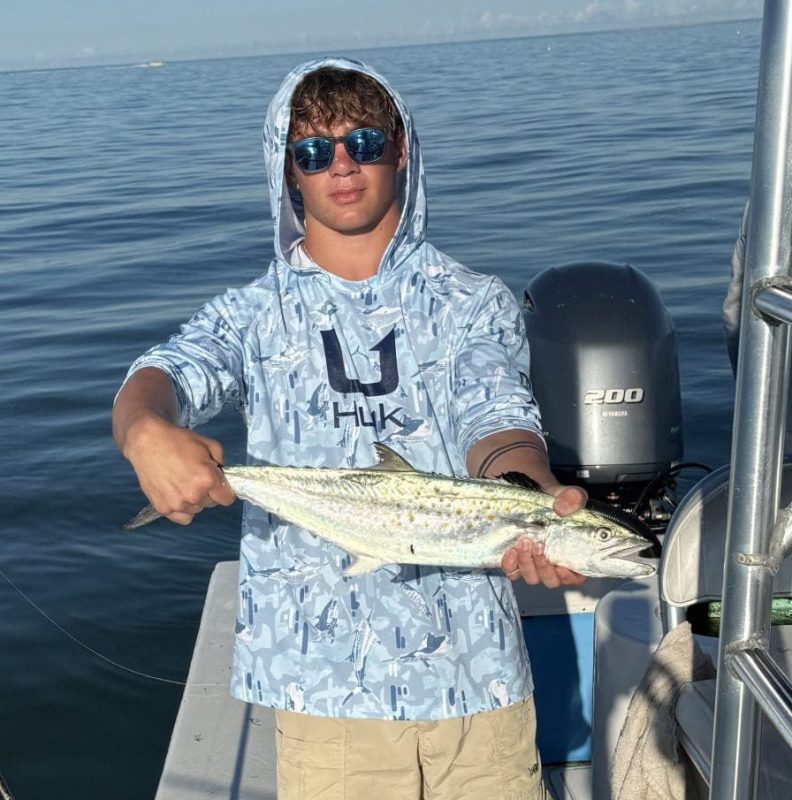Fishing Report October 1, 2024
Mack attack — Spanish mackerel invade local waters
With a large influx of bait fish, like scaled sardines and threadfin herring, surrounding Anna Maria Island, you can bet on finding Spanish mackerel in the nearshore waters of the Gulf and in the waters of Tampa and Sarasota bays.
The high-speed predators are on the feed as they migrate along our coast and are a popular catch among anglers.
Finding large schools of bait — especially smaller-size bait fish — is a great way to locate the toothy fish. In many instances, you’ll see the mackerel slashing through the bait schools and even skyrocket several feet out of the water as they ferociously feed in preparation of cooler waters approaching from the north.
Targeting Spanish mackerel can be done in a variety of ways using live bait or artificials. Catching macks can be as simple as free-lining a live shiner, combined with a long shank hook over any reef, wreck or rock pile where bait is present. And, you may not even need to be over structure as long as bait schools are dense.
Being a migratory species, mackerel are constantly on the move following the bait. So finding bait schools is pertinent. But, don’t think you have to have live shiners as bait because macks can be quite gluttonous. Casting live shrimp to hungry macks can yield a bite, especially in cooler springtime waters when live shiners are not as abundant.
If live bait isn’t your thing, you’re in luck as macks are prone to striking artificials. Employing lures can be productive when fishing around piers, jetties and in the passes. Generally, you’ll want to use a lure that matches the size of the bait you think the macks are feeding on.
Several spoons, like the Clark spoon or Krocodile spoon, are deadly when targeting macks. A quick retrieve along the edges of the bait schools will usually yield a strike as the macks swim so fast while feeding they don’t have time to decipher whether your spoon is a lure or a fish. They just react to the flash and the speed of the retrieve.
Other lures, like small jigs will work, too. An assortment of colors is good to have on hand to experiment with to see which color the macks prefer on a particular day. White, chartreuse or hot pink are the most popular.
Customizing your jigs with some flash will add to their effectiveness and you can get more bites.
It’s also advantageous to carry a surplus of jigs or spoons when using artificials because the macks have razor-sharp teeth. They can cut through a fluorocarbon leader so fast that the angler is unaware the line has even been cut.
You would think the addition of a steel leader would prevent this from happening, and you’re right. The steel leader will prevent the macks from hitting altogether as they can see that wire leader and will quickly turn away.
This being said, be prepared to lose some terminal tackle and lures will targeting Spanish mackerel. It’s just part of the experience.
For gear, medium-light spinning gear is ideal as mackerel are common in 18 to 22 inches. Using lighter spinning gear adds some sport to the experience because an angler can feel the power of the high-speed long drag-screaming runs and a fight to the end are indicative of a Spanish miracle when hooked. This combined with a beautiful array of colors displayed once the fish is visible makes the experience memorable, especially once a fish has landed and shows off the magnificent razor-sharp teeth.
As for table fare, mackerel are rated as excellent to eat. Although being a high-activity fish, they tend to be on the oily side, which for some is a turn off. Once caught, it’s best to slit the throat to bleed the fish and pack them on ice to preserve the quality of the meat.
It’s also best to prepare macks the day they are caught to ensure a mild, sweet flavor. Mackerel that is days old or that has been frozen can have a fishy taste as well as a soft texture so it’s best to plan on eating them the same day they are caught.
Preparation such as grilling, blackening or frying are a good bet. Although many local anglers also boast that macks make great sashimi and sushi when handled properly and eaten raw.
Whether being eaten or not, Spanish mackerel are one of the most popular inshore/nearshore species to catch in our waters. As we proceed into fall, the bite should get better and better.
On my own Just Reel fishing charters, I’m still catching plenty of mangrove snapper throughout the inshore and nearshore waters surrounding Anna Maria Island.
In fact, limits are attainable on most days as long as the seas are calm and the tide is right. Most catches are in the 12-inch range, although fish up to 16 inches are being caught.
In many instances, Spanish mackerel are present in the same areas as the snapper, leading to plenty of action on the surface as well as quite a few cut lines.
Snook fishing is quite good. Fishing along the beaches and the mangroves is producing good action on linesiders.
Lastly, spotted seatrout are abundant on most deep grass flats.

